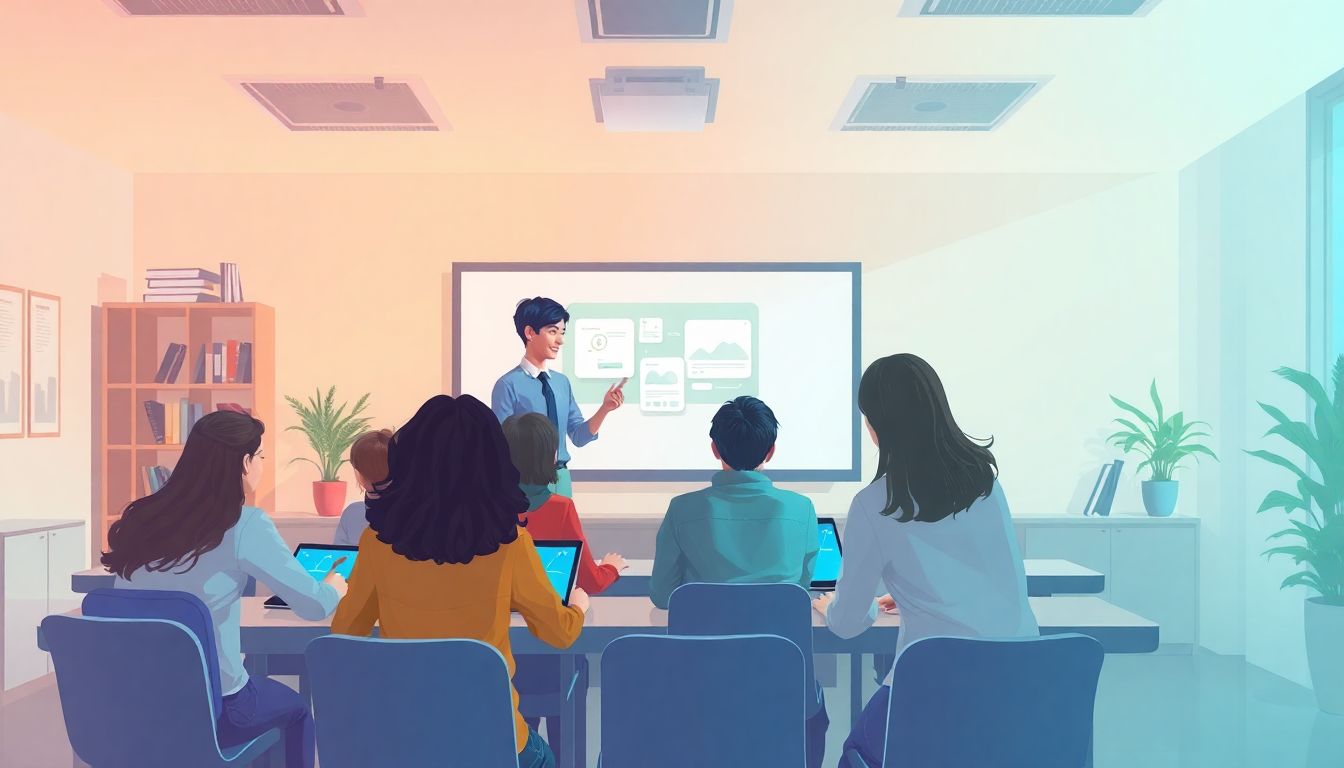Creating interactive lesson designs can sometimes feel like trying to herder cats—challenging and chaotic! You want lessons that engage students, but figuring out where to start can be a bit overwhelming. Don’t worry; you’re not alone in this struggle!
If you stick around, I’ll share useful prompts and strategies that will streamline your lesson planning process. By leveraging ChatGPT, you can turn your ideas into dynamic activities that captivate your students and foster a love for learning.
Together, we’ll explore everything from effective prompts to examples, benefits, and even how to tackle common design challenges. Get ready to elevate your lesson planning game!
Key Takeaways
- Prompts guide you in creating engaging and interactive lessons for students.
- Use ChatGPT to generate specific lesson ideas and structures quickly.
- Follow a clear step-by-step approach when forming prompts for better results.
- Interactive lessons boost student involvement and improve learning outcomes.
- Address challenges like time constraints and student engagement with strategic prompts.
- Incorporate technology and varied teaching methods to cater to diverse learning styles.

Prompts for Creating Interactive Lesson Designs
When it comes to designing interactive lessons, prompts can serve as a roadmap to inspire creativity and engagement.
Here are some actionable prompts you can use with ChatGPT:
- Create a lesson plan that includes hands-on activities for teaching the scientific method.
- Design an interactive lesson on folklore that incorporates storytelling and student presentations.
- Develop a multi-sensory lesson on ecosystems that includes visual aids, role-playing, and group discussions.
- Generate ideas for a classroom debate on renewable energy versus fossil fuels.
- Outline an interactive history lesson that brings a specific event to life through a simulation game.
Using these prompts, you can create lessons that not only convey information but also engage students in meaningful ways.
How to Use ChatGPT for Lesson Planning
Using ChatGPT for lesson planning involves leveraging its robust language model to generate ideas and structure for your lessons.
Here’s a step-by-step guide to maximize ChatGPT’s potential in your lesson planning:
- Start with a clear objective. For example, “Create a lesson that teaches the basics of algebra.”
- Utilize specific prompts, like “List three interactive activities for a lesson on the water cycle.”
- Request variations by asking, “Provide alternative assessment methods for a lesson on World War II.”
- Iterate based on feedback. If the output isn’t what you expected, refine your prompts for better results.
- Combine and customize generated ideas to fit your classroom needs.
This method allows you to harness the power of AI to ease lesson planning and add a fresh perspective to your teaching.
Examples of Interactive Lesson Design Prompts
Finding inspiration for interactive lesson designs can sometimes be a challenge, so here are some examples of prompts you can use:
- Generate a list of engaging group activities for teaching the water cycle.
- Create a project-based learning assignment that allows students to explore local ecosystems.
- Design a role-playing scenario for a history lesson on the American Revolution.
- Outline a scavenger hunt that teaches students about different types of habitats.
- Suggest digital tools that can be incorporated into a lesson about the solar system.
These prompts can enhance collaboration and ensure students are active participants in their learning journey.
Benefits of Interactive Lessons in Education
Interactive lessons have numerous benefits, primarily by fostering engagement and improving learning outcomes.
Here’s how interactive lessons can positively impact education:
- Encourage active participation, keeping students involved in the learning process.
- Enhance critical thinking skills as students are required to analyze and apply their knowledge.
- Promote collaboration among peers, fostering a sense of community and teamwork.
- Provide immediate feedback through interactive activities, allowing adjustments in teaching methods if needed.
- Make learning more enjoyable, which can lead to improved retention of information.
By implementing interactive strategies in lessons, educators can create a more dynamic and compelling learning environment.

Tips for Writing Effective Prompts for ChatGPT
Writing effective prompts for ChatGPT is an essential skill that can greatly enhance the quality of responses you receive.
Start by being clear and specific in your requests.
For example, instead of saying, “Generate lesson ideas,” say, “List five interactive lesson ideas for teaching fractions to fifth graders.”
This way, you’re giving ChatGPT a precise context to work from.
Another tip is to include desired outcomes.
Use prompts like, “Create a lesson plan for a group of varied learners that incorporates technology and promotes critical thinking.”
This helps tailor the response to fit your needs better.
Don’t hesitate to ask follow-up questions.
Once you receive a response, you can say, “Add more hands-on activities to that lesson plan” or “Suggest alternative assessments based on student performance.”
Here are some prompts you can copy and paste:
- “Provide a detailed lesson plan with interactive group activities for a biology class on the human body.”
- “Suggest three engaging ways to introduce the concept of gravity to elementary students.”
- “Outline a week’s worth of lesson plans focusing on environmental science that include technology and community involvement.”
- “List assessment methods for evaluating a project-based learning assignment in high school economics.”
- “Generate a script for a collaborative storytelling exercise that can be used in a language arts class.”
Challenges in Interactive Lesson Design and How to Overcome Them
Designing interactive lessons can come with its own set of challenges, but recognizing these can help you address them efficiently.
One common obstacle is lack of time for planning.
To combat this, leverage ChatGPT to quickly brainstorm ideas or create lesson outlines.
Another challenge is ensuring student engagement.
You might ask ChatGPT, “Suggest three strategies to boost student participation in group activities,” and use those insights to enhance your lesson.
Incorporating technology can also be daunting.
To ease this process, you can say, “List five user-friendly tech tools for enhancing classroom engagement.”
Here are some other useful prompts to tackle lesson design challenges:
- “Identify common pitfalls in interactive lesson plans and how to avoid them.”
- “Suggest alternatives to traditional assessments that can be integrated into interactive lessons.”
- “Generate a plan for how to manage diverse learning styles in a large class with interactive elements.”
- “List techniques for keeping students engaged in long-term projects.”
- “Propose solutions for addressing disruptions during interactive lessons.”

Feedback and Assessment Through Interactive Lessons
Feedback and assessment are crucial elements in interactive lessons that help students understand their progress.
One effective method is to create peer review opportunities where students assess each other’s work.
This not only encourages collaboration but also sharpens their evaluative skills.
Consider using interactive quizzes that provide immediate feedback, refreshing the learning experience.
Here are some prompts to help you utilize ChatGPT for feedback and assessment strategies:
- “Design an interactive quiz for assessing student understanding of ecosystems.”
- “Suggest peer assessment techniques for a group project on renewable energy.”
- “Generate ideas for immediate feedback methods during a classroom debate.”
- “Offer ways to incorporate self-assessment in a project-based learning environment.”
- “Outline a rubric for evaluating student presentations on historical events.”
Using these methods, you can create a more effective feedback loop that enhances student learning.
Additions to Enhance Engagement in Lessons
Enhancing engagement in lessons is vital for maintaining student interest and participation.
There are various methods to accomplish this, including incorporating technology and interactive tools.
One popular technique is gamification, which turns learning into a game-like experience.
Another strategy is using collaborative platforms that allow students to work together on projects in real-time.
Here are some actionable prompts for ChatGPT that can help you brainstorm ideas to boost engagement:
- “List five games or activities that promote engagement in a high school math classroom.”
- “Generate ideas for using virtual reality in a lesson about ancient civilizations.”
- “Suggest collaborative online tools that can enhance student participation in science projects.”
- “Create a plan for a classroom event that integrates multiple subjects in a fun way.”
- “Outline a strategy for incorporating multimedia resources into a lesson on literature.”
By applying these techniques, you can significantly elevate the engagement level of your lessons.
Resources for Further Learning on Interactive Lessons
To become more proficient in creating interactive lessons, accessing additional resources can be very beneficial.
Many online platforms offer courses focused on innovative teaching strategies and interactive methodologies.
Websites like Edutopia and TeachThought can provide valuable articles and best practices for educators.
Here are some resources you can suggest to ChatGPT to further your learning:
- “Recommend online courses on interactive teaching methods for educators.”
- “List books that focus on effective lesson design in a modern classroom.”
- “Suggest educational podcasts that explore interactive learning strategies.”
- “Compile a list of websites with free resources for hands-on teaching activities.”
- “Identify workshops or webinars focused on incorporating technology in lessons.”
These resources can support your development as a teacher and enrich your lesson planning efforts.
FAQs
Interactive lessons are teaching methods that actively engage students in the learning process through participation, collaboration, and hands-on activities. They promote critical thinking and facilitate deeper understanding of the subject matter.
ChatGPT can help educators generate lesson plans, design interactive activities, and create engaging prompts tailored to specific subjects. It saves time and encourages innovative approaches to lesson design.
Benefits of interactive lessons include increased student engagement, improved retention of information, development of social skills, and greater motivation to learn. They create a dynamic learning environment that accommodates diverse learning styles.
Common challenges include managing diverse learner needs, ensuring adequate resources, and balancing interaction with content delivery. To overcome these, implement flexible strategies, gather feedback, and utilize technology effectively.
